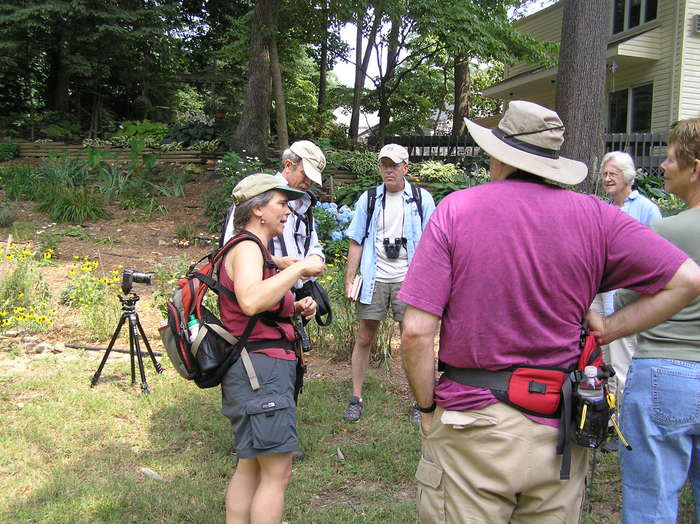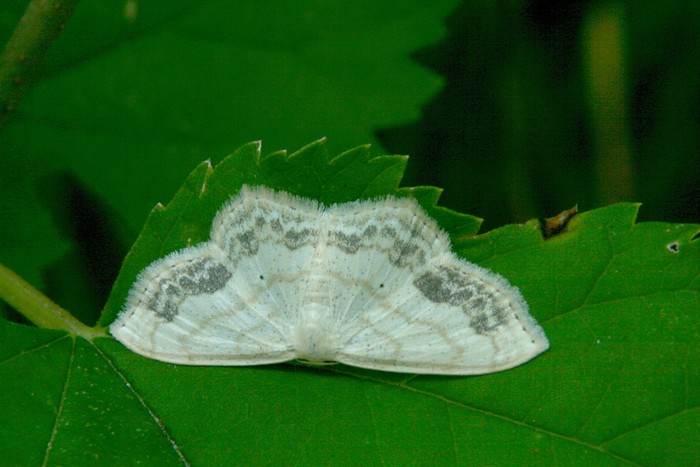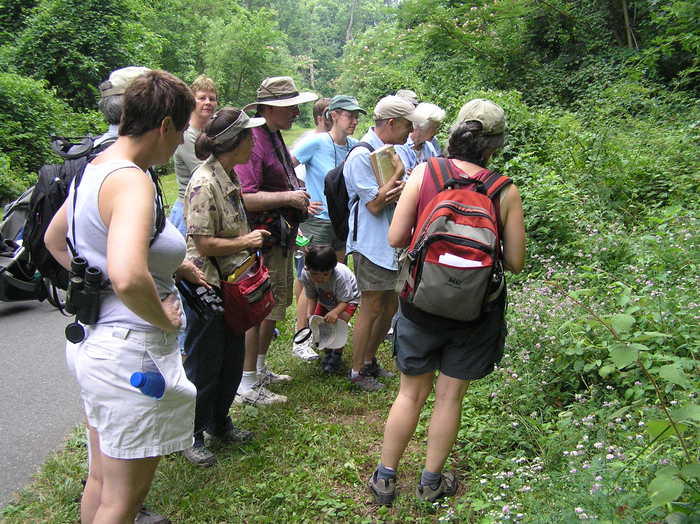Pollinators in late June:
An Outing in Lower Sligo
Saturday June 30, 2007
Guides: Frank Boyle and Rhonda Kranz
Twelve adults and three kids poked around the sunny edges of lower Sligo Creek Park, guided by Frank Boyle, who leads butterfly counts as part of the annual census conducted by the North American Butterfly Association. Before we set out, co-leader and ecologist Rhonda Kranz provided some background on pollinators and talked about Pollinator Week, being observed nationally. She noted the posting of a special selection of pollinator information on the Friends of Sligo Creek website and then we all went looking for pollinators in Sligo.
Walk leaders start us off with an introduction to pollination: Rhonda Kranz to the left,
Frank Boyle facing her with binocs on and field guides in hand.

Photo by Bruce Sidwell
We found these insects, many of whom are pollinators:
- Bees and wasps – Honeybee; Bumble Bees, big and small species; Sweat Bees; Leaf Cutter Bees; Carpenter Bees; Yellow Jacket; Paper Wasps; Potter Wasps; Shpecid Wasps; and a number of small, unidentified bees and wasps
- Butterflies and moths – Tiger Swallowtail, Cabbage White, Question Mark, Pearl Crescent, Juvenal Dusky Wing (very late in its flight season), Eastern Tent Caterpillars, (in nest 18 feet tall, only 3 feet off the ground), White Wave Moth (photo above/below)
- Other insects – Dragonflies, Leaf Hopper, Hoverflies, Bee Fly, true Bugs, and Japanese Beetles (many mating at the moment)
For more information about pollinators, check out our Pollinator List.
Pollinator at rest, creatively camouflaged: a White Wave Moth in the Geometer family. From a distance, it looks like a bird dropping when resting very flat against the leaf with wings outstretched.

Photo by Kevin Kirchner
Are all insects pollinators? Leader Frank Boyle explained:
Bumble Bees, Honey Bees, some flies, several ant specie,s and the smaller solitary bees are direct pollinators – for instance, Bumble Bees have specially adapted rear legs which carry pollen sacs from flower to flower. Some insects also feed on pollen. In our area, however, beetles, most moths, some bees, and butterflies may carry pollen from flowers, but it’s the nectar they are after.
We learned several facts about pollinators, for example that some are generalists (pollinating a variety of plants) and others are species-specific (they feed at and pollinator only a particular plant). Color matters to some, smell to others, e.g. bees can’t see bright red but do respond to other colors and to sweet smells; birds have a poor sense of smell so rely on shape and color. Most insects see into the far ends of the color spectrum – UV and infrared – and flowers have evolved an array of patterns and colors that we can only see through special camera lenses and other devices. Frank noted, “Our primate eyes are great for avoiding predators and for sensing movement, but there’s a whole ‘nother alien world out there!”
like one of the children, butterfly net in hand.

Along the way, we taught one another bits of lore – distinguishing wineberry from tall blackberry, tree identification, birds seen or heard along the way. Since she often walks this section, Kerry Stone could tell the rest of us bits like, “The [Great Blue] herons often perch up on that bare branch,” and “kingfishers are here every day”; she also pointed out last winter’s nest hole of Screech Owls.
When considering what would help Sligo pollinators flourish – and the ecosystems they serve – we saw that a change in mowing frequency along the PEPCO-owned power lines could alter buzz-cut terrain into higher grass meadowlands. Friends of Sligo Creek president Bruce Sidwell reported to the group that National History Chair Michael Wilpers has begun a discussion with PEPCO about the possibilities of a new mowing schedule. Bruce also mentioned the backyards-as-habitat certification program Takoma Park’s Wildlife Habitat Community Project and passed out information about it .

This outing is one in a continuing series sponsored by the Natural History Committee of Friends of Sligo Creek.
Text by Laura Mol


